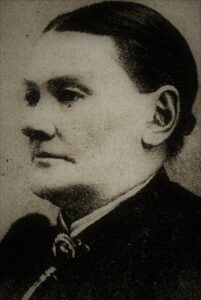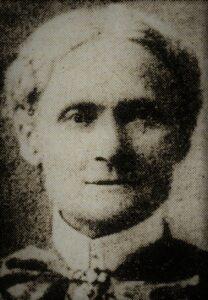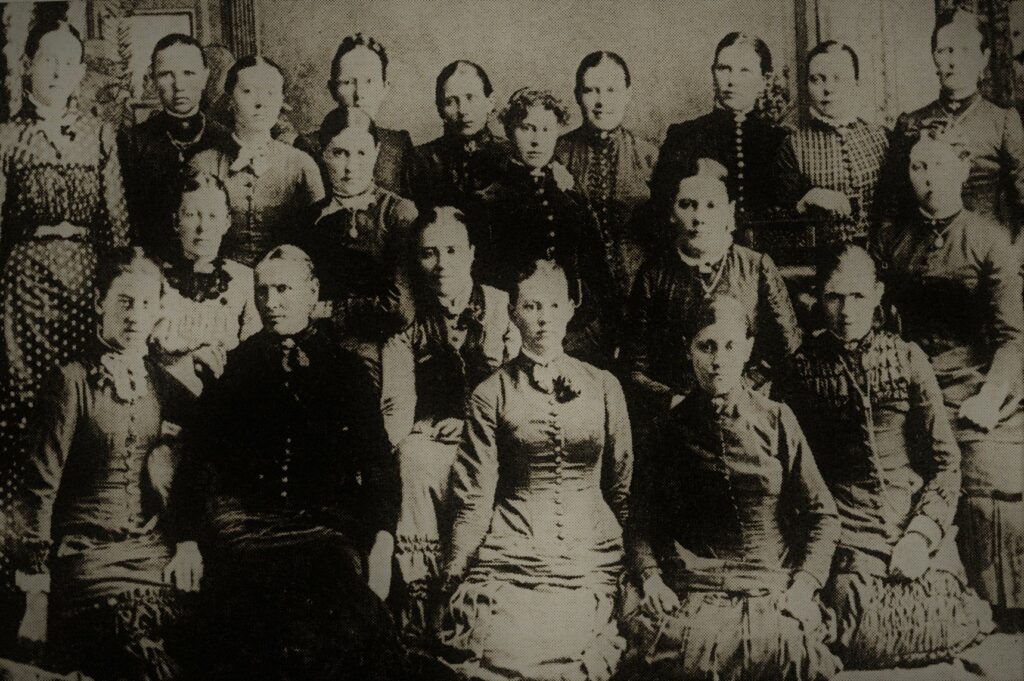
Rebekka Guðmundsdóttir was elected the first chairman of the Women’s Association in 1881. She was then a widow of Jón Árnason from Máná in Tjörnes.

Kristrún Sveinungadóttir and her daughter Svava Björnsdóttir took an active part in the activities of the Women’s Association from the beginning. They came west to Winnipeg in 1876.
Women’s Association Founded: In the years 1879-1881, the Icelandic community in Winnipeg grew significantly. Many people gave up on the trouble in New Iceland, moved from there to Winnipeg to gather strength and explore other opportunities. Individuals from the south in the United States and from Iceland added to the community. Everyone was aware of the need for the city to have some kind of Icelandic institution or association to help newcomers. This was an opportunity for Icelandic women to contribute. Several women came together and organized a lottery in September and the profit, 64 dollars, was given to the Framfarafélag’s (Progress Society) housing fund. There was general satisfaction with the initiative and it led to the establishment of a formal women’s society in Winnipeg on October 1st and the society’s first task was to stage the play “Sigríður Eyjafjarðarsól” (“Sigridur the Sun of Eyjafjord”), and with the profits they formed a society fund. Reverend Rögnvaldur Pétursson once heard a story about the founding of the society and says: “It was the beginning of this society, as one of the founders has told us, that some women and girls walked one day late in the summer west of town, for enjoyment, on the great grassy plain, which spreads as far as the eye can see north and west of Winnipeg …. When they came out on the plains, they sat down and started talking about the plight of the immigrants and others in town. They then agreed that they should establish an association among Icelandic women in Winnipeg, and that the association should do its best to help unemployed people and those organizations that could protect young and old from landing in the dust pile. These women were Rebekka Guðmundsdóttir and her daughter Guðrún Jónsdóttir, Kristrún Sveinungadóttir and her daughter, Svava Björnsdóttir, Þorbjörg Björnsdóttir, Signý Pálsdóttir, Helga Jónsdóttir and Hildur Halldórsdóttir. ” (SÍV4: pp.336-337) Rebekka was elected president of the association, Svava secretary, and Signy treasurer.
The society’s operations: In the first quarters, the society’s operations were characterized by various ways of raising funds to support various necessary projects of Framfarafélag and others. The society organized all kinds of meetings, e.g. raffles and theatrical performances, and then it regularly met with the general public or women members when the needs for donations arose. Wealthy women regularly donated to the society, others gave part of their salaries such as Guðrún Jónsdóttir. Her interest in the society’s work was unique and she donated half of her salary to it. The society donated to the Poverty Fund, supported the primary school management of Framfarafélag and the Hallgrímur Pétursson Memorial Fund in Iceland. Probably the most important job of the society each year was the assistance to newcomers from Iceland. For example, in 1883 when a large group (Vesturfaraskrá says that 1215 came west in 1883) came from Iceland to Winnipeg. The women then worked for two weeks in a so-called immigrant house in Winnipeg cooking to prepare for the arrival of the people. Leading in the project were Kristrún Sveinungadóttir and Sigurborg Pálsdóttir. Friðrik J. Bergmann wrote about this in Almanak 1904 p. 102: “Nothing in the history of Western Icelanders is more beautiful than how much they have taken care to be there from the first to the last to help and guide newcomers from Iceland in every way and often put a tremendous effort, not only financially, but with personal sacrifice in various ways.” In January, 1884, the society held a dinner meeting and the occasion was to raise money to build a house for Framfarafélagið, but the advertisement also said, “Now we are expecting a good priest from home this summer.” Every effort was made to make this midsummer gathering as successful as possible. The choice of speakers, poets and singers was elaborate. Friðrik J. Bergman wrote in the aforementioned Almanak p. 102-103: “And since this evening meeting is actually the first gathering that Western Icelanders worked hard on, it is most appropriate to explain what took place. First, meals were served and the guests were seated at well-prepared tables, which were loaded with delicious and expensive food. Following the meal, speeches and singing began. A poem was sung to the guests by Vilhelm Pálsson, and a speech was given by S. Stefánsson about the purpose of the gathering; Árni Friðriksson spoke in honor of the women; Sigurður Jóhannesson and Bárður Sigurðsson both performed poems for the Women’s Society; Jón Runólfsson speaks for the importance of music; Baldvin Baldvinsson delivers a speech on equality between men and women, while Vilhelm Pálsson gives a poem, Lýðhvöt. Magnús Pálsson spoke to children and teenagers and a poem by Vilhelm Pálsson was sung afterwards. Kristrún Sveinungadóttir spoke about the educational status of Icelandic women. Páll Magnússon gave a speech to the Women’s Society, Jón Björnsson spoke about freedom and how people should use it. Then Vilhelm Pálsson spoke about fiction and Magnús Pálsson closed the gathering on behalf of the Women’s Society and the gathering was ended by singing the national anthem in English: God Save the Queen.”

Womens Society in Winnipeg in 1881. Photo: HIPM
Changing times: The Winnipeg Women’s Society was particularly successful for some five to six years, but then interest in the group declined. The First Lutheran Congregation in the city was booming, and some women wanted to focus their efforts there. Some kind of division within the women’s society took place, younger women, relatively new to the women’s society, were more in favor of cooperating with the congregation. Those who had paved the way and worked in the group from the beginning, women like Kristrún Sveinungadóttir, Guðrún Jónsdóttir and Signý Pálsdóttir, had a hard time accepting such ideas. The small projects faded over time, the activities decreased and the number of female members decreased, some resigned from the society and others stopped all participation. Around the year 1890, the society was finally dissolved. The Progress Society was similar, it flourished in the years 1881-1885 but then came a turning point. Reverend Jón Bjarnason plays a part in the decline of these two societies, because when he returns to Winnipeg and allows social life in the rather weak congregation in the city, people flock to the pastor and strengthen the activities of the congregation. The same thing was done by young women from the Women’s Society, and on August 5, 1886, many of them joined a new women’s association founded by Lára Guðjohnsen, the wife of Reverend Jón Bjarnason. It was called the Women’s Society of the First Lutheran Church.
English version by Thor group.
